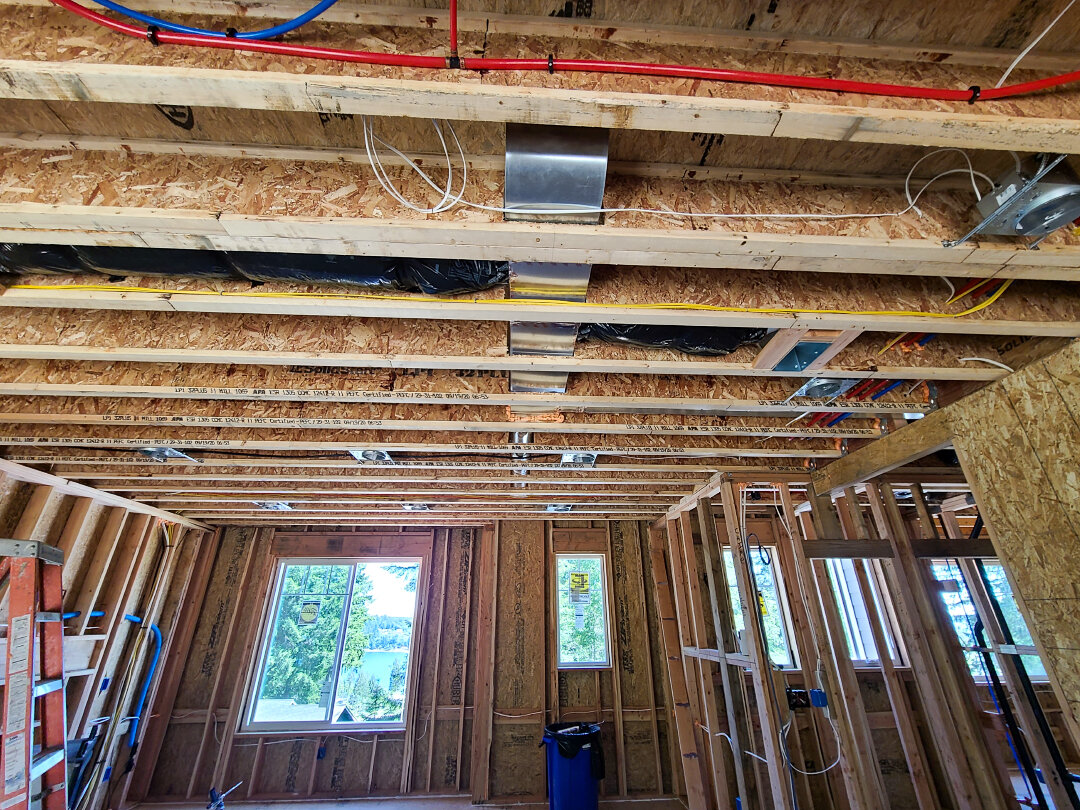Square Holes in I Joists?
What the What?
We recently had a project where the mechanical design had no choice but to put ducting through the webs of the 14” I Joists. This didn’t seem like a big deal to me, we just submitted the design to the I Joist manufacturer for permission since it fell outside the prescriptive “Web Hole Specification” chart in the I Joist guide. Now I want to mention that we are talking 14” I Joists spanning 20’ and asking for a 13” x 9” rectangular hole!
Boise Cascade had introduced the Conditioned Airspace HVAC framing at the International Builders Show 2011
I had this BEFORE I cut the holes 😁
We sent the request in an had a response with documentation a few hours later. I went ahead and laid out and cut the holes for the HVAC contractor. To me there was no discernable difference when I jumped on the joists before and after the holes were cut. I posted to Instagram what I did and why, never thinking about the fire storm I was about to start……
……………I Joist Webgate had begun.
425,000 views and nearly 400 comments later (about half were mine defending what happened) and I realized the need for education. I kept posting the references to prove that this was ok, but its hard to “reason someone out of something they didn’t reason themselves into” in the first place. Let’s just say there was quite a bit of vitriol including the classic “I don’t care what references you provide, common sense dictates…” It’s a shame that there is no testing and guidance from the manufacturers on this (insert snarky smirk emoji).
Why don’t you explain this to me like I am an eight-year old.” - Michael Scott
How Do I Joists Work? “I-joists are strong, lightweight, "I" shaped engineered wood structural members that meet demanding performance standards. I-joists are comprised of top and bottom flanges, which resist bending, united with webs, which provide outstanding shear resistance. The flange material is typically laminated veneer lumber (LVL) or solid sawn lumber, and the web is made with plywood or OSB. The robust combination of structural characteristics results in a versatile, economical framing member that is easy to install in residential and light commercial projects.”- APAwood.org
There is a great blog over at Wesbeam.com written by a Structural Engineer and can be read here. I’ll borrow a drawing and show it here.
engineers are the best doodlers
Top flange is in compression when loaded and the bottom flange are in tension when loaded. Out near the middle of the joist the web is mostly acting as a “spacer”, but along the length of the joist the web sees “shear” forces (see drawing above). Shear forces are much higher near the supports and this knowledge allows for holes, even rectangular holes, to be cut in certain places without reducing the strength of the joist.
Michael: “Why don’t you explain this to me like I’m five.”
Another great explanation can be found here by Paul Fisette. Basically as the joist deflects downward (forming an arc) the wood fibers are stressed horizontally. In the top flange the fibers are compressed and the bottom flange they are stretched (tension). At some point though, the wood fibers are NEITHER shortened (compressed) or stretched (tension). This is called the neutral axis.
This explains why we can drill circular or rectangular holes IN CERTAIN LOCATIONS AND SIZES.
Software. Quite a few I Joist manufacturers have software, some even available for download, that they enter the design variables and get an answer(s) and alternative solutions. I Joists have been around since 1969 when Trus Joist Corporation brought them to market.
Hole Cutting Guides
A Major Caveat Though
I was writing tongue in cheek for much of this blog and definitely don’t mean to imply anyone is an 8 year old or 5 year old in understanding just because this is new to them. I just really love that quote from The Office and frequently use it when I don’t understand something.
Here is the caveat: Follow the manufacturers guidelines to the letter. Don’t cut, drill or notch and ask for permission later. It really is easy to ask for permission and often the answer might be no UNLESS…… Work with the designer, engineer, manufacturer to develop solutions. Like the old proverb says “there is accomplishment through many advisers.”



